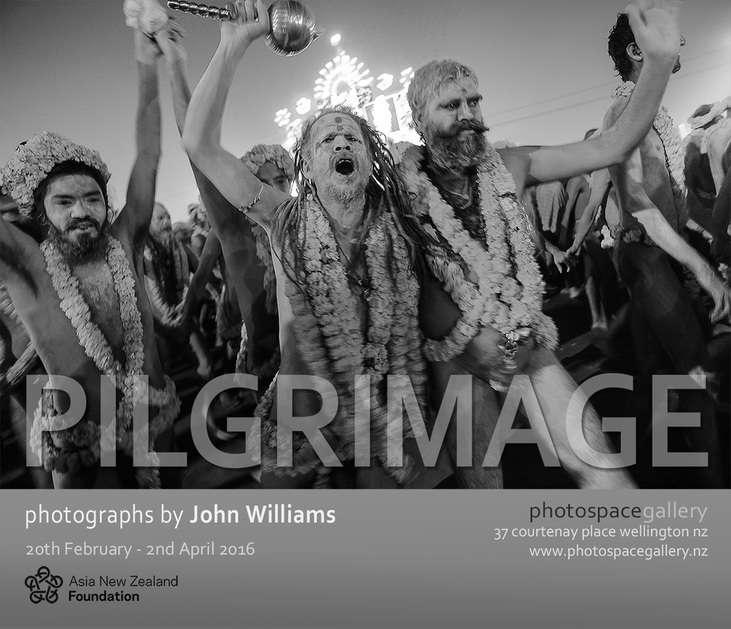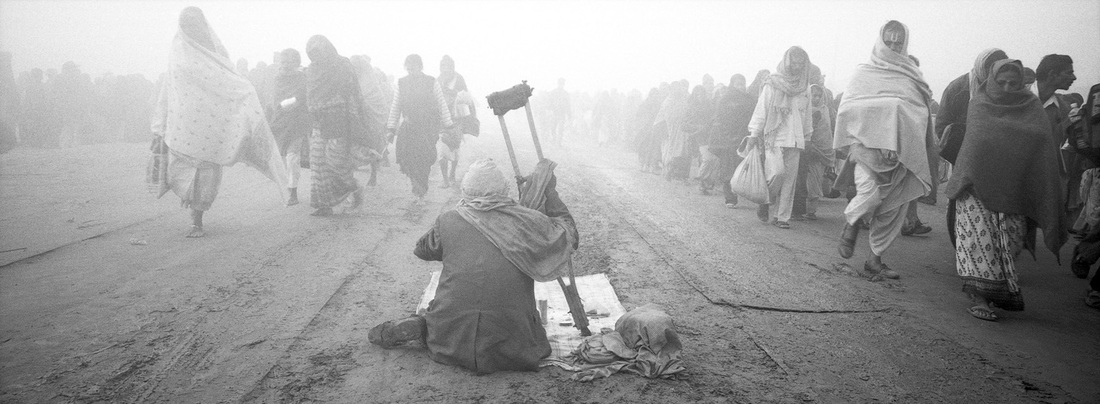 'Pilgrimage' exhibition poster (draft) John Williams, Photospace Gallery 20th February - 2nd April 2016. Image: Naga babas (naked holy men) of the Mahanirvani Akhara celebrate on their way to bathe in the confluence of the Ganges and Yamuna rivers during the maha kumbh mela, Allahabad, India 15th February, 2013 PilgrimageAs a documentary photographer, I have been exploring issues of faith and worship for a number of years. This has included several self-funded trips to India to photograph in- depth projects that explore aspects of pilgrimage. This exhibition combines photographs from these projects including: the greatest congregation of people in the world (the Ardh and Kumbh Melas at Allahabad), the Gangasagar Mela at Sagar Island in the Bay of Bengal, the pilgrimage to climb Sri Pada (Adams Peak) in Sri Lanka, and the pilgrimage to die in India's holiest city, Varanasi. The first collection of work comes from the Ardh and Kumbh Melas held at Allahabad, northern India. These events perhaps embody the concept of pilgrimage in India, as every Indian is meant to attempt a pilgrimage to a Kumbh at least once in their lives. The origins of the kumbh mela are ancient and Hindu mythology tells of a battle for the nectar of life, which was produced from the churning of the milk ocean and placed into a pot (kumbh). The coveted kumbh was spirited over India by the physician of the gods, who, en route to paradise, stopped to rest in four places. Allahabad is the most auspicious of these, because of the confluence of the Ganges, Yamuna and Saraswati rivers at the Sangam. There is a mela (fair) here every year, a half or ardh mela every six years, a full or kumbh mela every twelve years and a maha kumbh mela every one hundred and forty four years. On these occasions the banks of the river are turned into a religious fairground as millions of pilgrims come to bathe in the sacred rivers. The maha kumbh mela of 2013 was the largest festival to date lasting a marathon 55 days and attracting a guesstimated 30 - 40 million people on Mauni Amavasya, the main bathing day. An "estimated 40 million people came to Allahabad, in the northern state of Uttar Pradesh, on Sunday to bathe at the confluence of the Yammuna and Ganges rivers and the mythical Saraswati River. It's the most significant Hindu pilgrimage, occurring every 12 years,” said Indian cultural and political observer K. G. Suresh. (CNN, 2013) and 100 million people across the length of the festival, making this the largest ever gathering of humankind. While I attended both the ardh mela in 2007 and the maha kumbh mela in 2013 this will be the first time that the work from both events will be exhibited together. The second collection of photographs comes from the Gangasagar mela held on Sagar Island situated in the Bay of Bengal. Sagar Island is normally a quiet rural island of small villages but for a few days in January each year it becomes home to hundreds of thousands of pilgrims as they flock to bathe at the last place in India where the Ganges flows into the sea. The third collection of work comes from the pilgrimage to climb Sri Pada or Adams Peak, a holy mountain in Sri Lanka. Adams Peak is a multi faith pilgrimage site as Christians, Hindus and Buddhists climb the 5,500 steps up the mountain in the dark to witness the sunrise from the top. The last selection of work comes from two projects undertaken in Varanasi, India. While many of us are familiar with the Hindu belief in reincarnation some devout Hindus attempt to escape this process. "In a region of northern India, some people at the end of their lives leave their villages and travel to the Hindu holy city of Kashi [Varanasi] to die. These pilgrims expect that by dying in Kashi they will obtain the spiritual reward of moksha - liberation from the cycle of death and rebirth." (Justice. 1997). This process is facilitated by the pilgrims’ staying at places such as the Kashi Labh Muktibhavan where they and their families are given a room to stay in until the pilgrim dies, a process that may take hours, days or weeks. An alternative to this version of obtaining moksha is for the pilgrims to retire to Varanasi and take up long term residence at somewhere such as the Kashi Mumukshubhavan. Here they may rent a room and live out their days as they await death and spiritual release. John Williams info John Williams has been a involved in photography for over 20 years working as a freelance photographer and photographic lecturer/tutor. His major area of practice has always been firmly rooted in the documentary genre. For a number of years he has been fascinated by the spiritual beliefs and religious activities that people engage in and this has become the major body of work he has been undertaking. John has exhibited in various group and solo exhibitions at Photospace Gallery since 2004, the first being his solo show 'Domestic Bliss, part I' in 2004. He has also exhibited at Photospace as part of the Exposed Photography collective. Qualifications Master of Education (Adult Education) (Massey University) Postgraduate Diploma in Education (Adult Education) (Massey University) Bachelor of Design (Hons) (Photography) (Massey University) Advanced Photographic Certificate (Wellington Polytechnic) Professional Photographic Certificate (Wellington Polytechnic)
2 Comments
|
AuthorPhotography Matters II Categories |





 RSS Feed
RSS Feed
